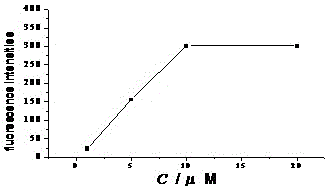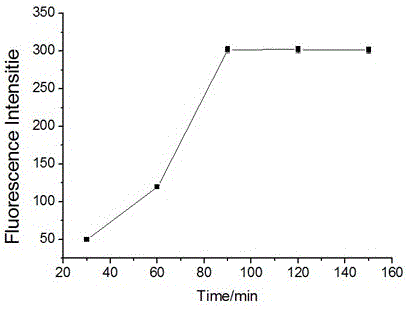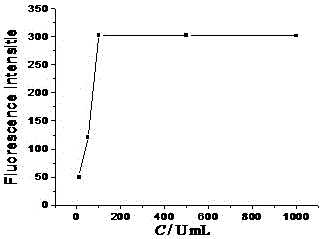One step amplification method of fluorescence detection for mercury ions
A fluorescence detection, mercury ion technology, applied in the field of fluorescence detection, can solve problems such as the inability to form a double-stranded structure, and achieve the effects of fast reaction speed, improved sensitivity, and high-sensitivity detection.
- Summary
- Abstract
- Description
- Claims
- Application Information
AI Technical Summary
Problems solved by technology
Method used
Image
Examples
Embodiment 1
[0036] (1) Put 7ulH in a 200ul centrifuge tube in sequence 2 O, Probe1 chain 2ul (0.1uM), Probe2 chain 2ul (0.1uM), 1ul target mercury ion, different concentrations of HAP chain 5ul (1uM, 5uM, 10uM, 20uM), Nt.BbvCI buffer 2ul, Nt.BbvCI enzyme 100Uml, make 20ul homogeneous system. Shake on a shaker for 30s and mix well.
[0037] (2) Then put the mixed mixture into a 37°C incubator and incubate for 2h.
[0038] (3) Set the excitation wavelength to 494nm, the emission wavelength range to 500nm-630nm, the incident slit to 5nm, and the exit slit width to 3nm; start testing its fluorescence intensity.
[0039] The experimental results are as follows figure 1 As shown, as the concentration of HAP chains increases, the fluorescence intensity obtained in the experiment increases continuously, until the concentration is 10uM, the fluorescence intensity remains basically unchanged. Therefore, when the HAP chain concentration is 10uM, the experimental effect is the most obvious, and ...
Embodiment 2
[0041] (1) Put 8ulH in a 200ul centrifuge tube in sequence 2 O, Probe1 chain 2ul (0.1uM), Probe2 chain 2ul (0.1uM), 1ul target mercury ion, HAP chain 5ul (50uM), Nt.BbvCI buffer 2ul, Nt.BbvCI enzyme 100Uml, make a 20ul homogeneous system. Shake on a shaker for 30s and mix well.
[0042] (2) Then put the mixed mixture into a 37°C incubator and incubate for different times (30, 60, 90, 120, 150, 180min).
[0043](3) Set the excitation wavelength to 494nm, the emission wavelength range to 500nm-630nm, the incident slit to 5nm, and the exit slit width to 3nm; start testing its fluorescence intensity.
[0044] Under the experimental results figure 2 It shows that with the increase of the incubation time, the fluorescence intensity obtained in the experiment is continuously enhanced, and after the reaction time of 120min, the fluorescence intensity remains basically unchanged. Therefore, when the reaction time is 120min, the experimental raw materials are fully utilized, and the...
Embodiment 3
[0046] (1) In a 200ul centrifuge tube, put 1ul and 8ulH of the target mercury ion in turn 2 O, Probe1 chain 2ul (0.1uM), Probe2 chain 2ul (0.1uM), HAP chain 5ul (10uM), Nt.BbvCI buffer 2ul, add different amount of Nt.BbvCI enzyme (10Uml, 50Uml, 100Uml, 200Uml, 500Uml) Make 20ul homogeneous system. Shake on a shaker for 30s and mix well.
[0047] (2) Then put the mixed mixture into a 37°C incubator and incubate for 120min.
[0048] (3) Set the excitation wavelength to 494nm, the emission wavelength range to 500nm-630nm, the incident slit to 5nm, and the exit slit width to 3nm; start testing its fluorescence intensity.
[0049] The experimental results are as follows image 3 It was shown that with the increase of the amount of endonuclease, the fluorescence intensity obtained in the experiment was continuously enhanced, and after the amount of enzyme reached 100Uml, the fluorescence intensity remained basically unchanged. It shows that the amount of enzyme required to catal...
PUM
 Login to View More
Login to View More Abstract
Description
Claims
Application Information
 Login to View More
Login to View More - R&D
- Intellectual Property
- Life Sciences
- Materials
- Tech Scout
- Unparalleled Data Quality
- Higher Quality Content
- 60% Fewer Hallucinations
Browse by: Latest US Patents, China's latest patents, Technical Efficacy Thesaurus, Application Domain, Technology Topic, Popular Technical Reports.
© 2025 PatSnap. All rights reserved.Legal|Privacy policy|Modern Slavery Act Transparency Statement|Sitemap|About US| Contact US: help@patsnap.com



